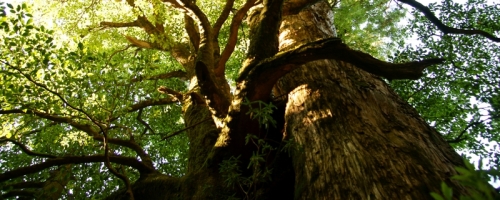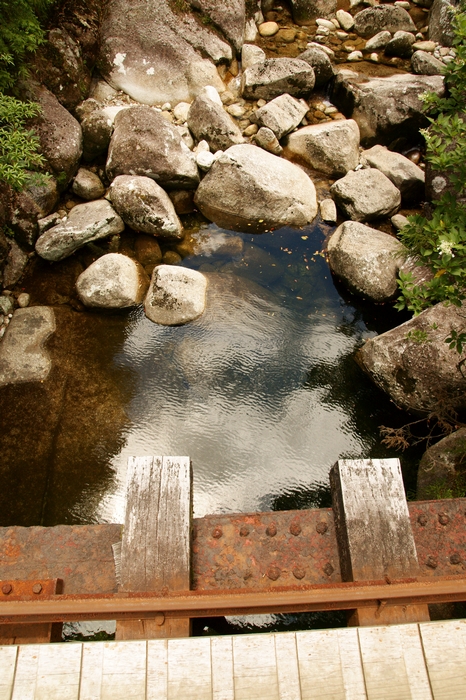We were in Yakusugi Land and the next important stop was the Wilson Stump. The English botanist Ernest Wilson had found the stump during a visit to the island in 1914 and his account of the stump introduced the great Yakusugi trees to the world. For me, the history of the tree’s death is very interesting. The tree was ordered to be cut down by the famous daimyo, Hideyoshi Toyotomi and the wood was to be used for the construction of a great temple, which was begun in 1586. The proposed Hokoji was to give Kyoto a temple bigger and more impressive than the Todaiji in Nara, and it was to house a statue of the Buddha that would be bigger than the one in Todaiji. The temple took ten years to construct and it was opened with great pomp and ceremony, with 1,000 Buddhist priests present. A year later, a great earthquake toppled the temple. Reconstruction took place, but a careless worker set fire to the structure and it burned down. For a long time the temple was left but at last the order came to rebuild it again, this time by Hideyoshi’s son as the patriarch had since passed away. Reconstruction was completed, but again an earthquake collapsed the temple and after it was reconstructed yet again, it was struck by lightning and set ablaze twice, the second time completely razing the ill-fated structure to the ground. If you were superstitious, you might believe that there was a curse upon the wood of the Yakusugi.
The tree is believed to have been 3,000 years old. The hollow inside of the stump is ten tatami mats in size (the average bedroom size in Japan being six tatami mats). From one corner of the stump, when you look up, the opening takes on a heart shape. The younger trees around the stump (kosugi, as they are not over 1,000 years of age yet) grow up straight and tall, nearly 50 metres high. Kikuchi-san explained that deeper in the valley the trees are protected from the wind and can grow like this. The Jomon sugi is higher up the slope and exposed to the sometimes strong winds that blow over the island, so it and its neighbours don’t stick their necks up too high. We would be reminded of this a little further down the mountainside.
Kikuchi-san also offered a lecture to the camera about the wheel tree (Trochodendron aralioides) or yamaguruma. This tree can often be found hugging the Yakusugi with its roots. The tree appears to be clinging to the cedars and in some cases the grip of the wheel tree is sunken into the softer wood of the cedar. Kikuchi-san stopped before “The Strangling Tree” for his monologue and pointed out how the wheel tree appeared to be choking or strangling the cedar. He explained, however, that the wheel tree was not harming the cedar and that it was not a parasite leaching nutrients from the host tree. Wheel trees with their radial-spreading leaves require sunlight but in the shadows of the conifers the saplings can’t get enough light. So many of the dispersed seeds land on branches and in crooks of dual trunks where there are not only nutrients in the detritus of fallen leaves and needles, but also closer access to sunlight. The trees grow and as they do they send their roots down into the soil, holding on to the cedar trunks and “squeezing” them as both trees grow in size.
Currently, only one species of wheel tree exists in the world. There used to be seven species but the other six have become extinct.
The wheel tree is not the only species of plant that takes advantage of the sunward accommodation provided by the Yakusugi. Mosses and ferns are the obvious occupants you would expect to find but there are also a species of rhododendron and mountain ash or rowan as well as other plants whose seeds might find a comfortable cradle in which to germinate. A poster on the wall in the stairway of my hotel bore the detailed illustration of a Yakusugi and all the different plants growing from the hanging gardens.
We also stopped at an opening in the forest canopy that had until recently been filled up by the Okina sugi. Previously the second largest of all the Yakusugi, the Okina sugi fell in a September storm a couple of years ago (remember those strong winds?). Now a huge hole known as a gap was open above and sunlight bathed the forest floor. On the now rotting wood of the ancient tree, new sprouts were beginning the next phase of forest life.
Mr. Hatanaka wanted a shot of me photographing a sprout in the sunlight to help illustrate the recycling of the forest. A tiny plant still bearing its seed casing was the perfect specimen and I had my macro gear ready. However, when I carefully placed one tripod leg over the ropes protecting this fragile piece of forest and set it gingerly on the bare wood of the Okina sugi, alarm was raised and several voices at once spoke out in objection. “You mustn’t step over the ropes.” Though I always try to respect the ropes and what they are protecting (the nature or me), I often permit a tripod leg over the ropes if it is carefully placed on a rock or piece of wood and not harming any small plants. But here among the guides (two others had come up with clients), the tourists, and the TV crew who had to follow and respect the rules in the name of NHK’s good reputation, even a tripod leg entering a “humans keep out” zone of a UNESCO site was treated as a sacrilege and we were quickly encouraged by the director to move on to another suitable location.
Getting that shot of newly sprouted leaves in sunlight was a challenge we could not easily meet. Though sun came in here and there, there were no ideal subjects. And when a suitable specimen had been found at the side of the trial, the tourist traffic had greatly increased and people were passing us like trains of refugees. Or more like pilgrims as they were all making the climb up to the Jomon sugi.
Getting down proved to be a test of patience. We were in a hurry but every two to four metres of path gained we had to step aside and let the climbing groups pass. These groups included anywhere from 5 to a dozen people. At the top of a long flight of steps we waited for over 30 people to come up. As each small group began climbing the steps, another group would arrive and begin climbing. At last we were able to descend, this pattern up hurry and a wait nearly driving me to distraction. Kikuchi-san remained at ease. The climbing parties had priority – simple as that. We could not possibly go any faster.
All along the way down, my eye caught site of the akahoya – a layer of red clay that coats most of the island. As mentioned already in a recent post, this clay is of volcanic origin and was deposited during the explosive eruption of the Kikai Caldera volcano 7,300 years ago. I found what I was looking for and pried lose a chunk of pumice that fit over my palm. I showed Mr. Sasaki and Mr. Ohkawa and asked Kikuchi-san to explain to them about the eruption. Actually, I had poked at a piece of pumice while climbing in the sub-alpine zone the previous day but at the time it didn’t occur to me at all that I was probing the akahoya. Only now when it was fresh on my mind did I realize that the “rotten granite” I puzzled over was actually porous volcanic rock. I could have smacked my forehead!
Our last stop was the old village site. Following the old trolley rails that used to bring the cut wood of the cedars to the coast, we came to the historic site of the village that used to house the woodsmen and their families. The schoolyard and the stone foundation of the school was all that remained. In 1970, the last class had graduated from the elementary school and the village buildings were dismantled. The cutting of trees on Yakushima had come to an end two years before the first Earth Day. Already the priceless value of the great trees had become appreciated and the trees protected. And it would not be for another 24 years before parts of the island would become a World Heritage Site.
After a few shots around here (where the sun baked down upon our exposed heads), Our shooting party began to break up. I walked with Kikuchi-san while the others broke off in small groups after speaking with Mr. Hatanaka. We would all meet up again at the parking lot where the taxi van would be waiting for us.
Passing a large exposed slope of granite, Kikuchi-san and I noted the parched and withered looking sundew plants and mosses. Only a few steps away water trickled from the shade between cracks in the rocks. How cruel for a plant that lives on a rock face usually moistened with water to suffer this drought. For with the sun baking down on the rock, the surface life indeed reflected drought circumstances. Thankfully for those hardy enough to survive, that was all to change in abut 40 hours.









These posts about the production are a very nice complement to the episode that aired here in the US this week. Thanks for the additional information and peek behind the scenes.
Thank you, Josh, and I’m glad you saw the program. It was a very interesting and enjoyable experience for me to be a part of the shooting, so I wanted to write about it for my own sake first but also to share the story with anyone who was interested in reading too.